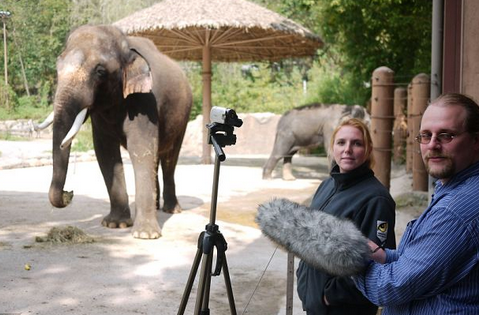(单词翻译:单击)
听力文本
An elephant in Korea has become a language student. Koshik, a 22-year-old male elephant, is already fluent in speaking "elephantese," but he is now trying to learn the Korean language Hangul. A report about Koshik was printed in the online journal "Current Biology". The author of the report is Dr Angela Stoeger-Horwath, who works at the University of Vienna in Austria. Researchers said Koshik has been listening to human speech for many years and has slowly learned to copy it. He can now say the Korean for hello, sit down, no, lie down, good, not yet, and yes. Dr Stoeger-Horwath asked 16 Koreans to listen to 47 recordings of Koshik. They could all understand what he was saying.

The researchers gave a few reasons why they think Koshik can talk. One possibility is that he has a very close relationship with his trainer, Kim Jong-gab. Mr Kim often sleeps near Koshik to keep him company. The trainer talks to him every day, so Koshik copied what he heard. Another is that the elephant is lonely and wants to communicate with people and have friends. The research team said the way Koshik makes sounds is very unusual,he uses his trunk to reproduce human speech. They said he is much better at making vowel sounds than consonant sounds. Trainer Kim Jong-gab said he has one more phrase that he wants to teach Koshik,"Saranghae," or "I love you."
中文翻译
一头韩国大象开始学习语言。22岁的公象Koshik能够说一口流利的“大象语”,他目前正在学习说韩语。Koshik的报道刊登在了《当代生物学》杂志的网页上。报告作者为安吉拉·施特格尔·奥尔瓦特博士,目前在奥地利维也纳大学工作。研究人员认为Koshik受人类语言熏陶多年,并逐渐开始进行模仿。如今,他能够发出“你好”“坐下”“不是”“躺下”“好”“还没”以及“是的”。施特格尔·奥尔瓦特博士让16名韩国人听了Koshik的47条录音。他们都能够明白Koshik所说含义。
研究人员对Koshik的语言天赋给出了以下几点原因。其中一种可能是Koshik与驯兽师Kim Jong-gab的感情非常好。Kim先生经常与Koshik睡在一起。驯兽师每天与他讲话,Koshik进行模仿。另一种可能是Koshik非常孤独,他希望与人类进行沟通,交朋友。研究小组认为,Koshik的发声方式非常特别,他利用象鼻来制造声音。他们认为Koshik的元音要好于他的辅音。驯兽师Kim Jong-gab认为,他还想教Koshik一句话,“我爱你”。
译文属可可原创,仅供学习交流使用,未经许可请勿转载
重点讲解
1.human speech 人类语言
例句:Birdsong may have more in common with human speech than we realize.
鸟类唱歌和人类的语言之间很可能有我们所意想不到的共同之处.
2.try to 设法
例句:I try to remember all the good times I've had here.
我试着回忆在这里度过的所有美好时光。
3.listen to 听…(讲话)
例句:The students are listening to their teacher in class.
学生们正在课堂上听老师讲课。
4.sit down 坐下
例句:Teachers staged a sit-down protest in front of the president's office.
老师们在校长办公室门前举行了一场静坐抗议。
听力题目
1.Koshik the elephant is
a. 20
b. 21
c. 22
d. 23
2.Koshik is fluent in
a. "elephantese"
b. "elephantian"
c. "elephantish"
d. "elephantic"
3.The name of the journal is
a. "Current Physics"
b. "Current Biology"
c. "Current Chemistry"
d. "Current Zoology"
4.How long has Koshik been listening to Korean?
a. several years
b. numerous years
c. years and years
d. many years
5.How many Koreans listened to the recordings?
a. 616
b. 60
c. 16
d. 66
6.How many reasons did researchers give for Koshik's ability?
a. dozens
b. a few
c. hundreds
d. a lot
7.Why does Kim sleep near Koshik
a. To keep him safe
b. To keep him happy
c. To keep him from waking up
d. To keep him company
8.What does Koshik use to speak?
a. His tongue
b. His trunk
c. His mouth
d. All of the above
9.What is Koshik better at?
a. Making happy sounds
b. Making vowel sounds
c. Making clicking sounds
d. Making consonant sounds
10.What does Mr Kim want to teach Koshik?
a. I love you
b. Smile please
c. My name is Koshik
d. Have a nice day
听力答案
1.c
2.a
3.b
4.d
5.c
6.b
7.d
8.b
9.b
10.a


